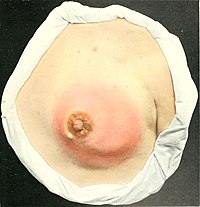
Photo from wikipedia
Despite the known benefits of breastfeeding for both infant and mother, clinical support for problems such as benign inflammation of the lactating breast remain a research frontier. Breast pain associated… Click to show full abstract
Despite the known benefits of breastfeeding for both infant and mother, clinical support for problems such as benign inflammation of the lactating breast remain a research frontier. Breast pain associated with inflammation is a common reason for premature weaning. Multiple diagnoses are used for benign inflammatory conditions of the lactating breast which lack agreed or evidence-based aetiology, definitions, and treatment. This article is the second in a three-part series. This second review analyses the heterogeneous research literature concerning benign lactation-related breast inflammation from the perspectives of the mechanobiological model and complexity science, to re-think classification, prevention, and management of lactation-related breast inflammation. Benign lactation-related breast inflammation is a spectrum condition, either localized or generalized. Acute benign lactation-related breast inflammation includes engorgement and the commonly used but poorly defined diagnoses of blocked ducts, phlegmon, mammary candidiasis, subacute mastitis, and mastitis. End-stage (non-malignant) lactation-related breast inflammation presents as the active inflammations of abscess, fistula, and septicaemia, and the inactive condition of a galactocoele. The first preventive or management principle of breast inflammation is avoidance of excessively high intra-alveolar and intra-ductal pressures, which prevents strain and rupture of a critical mass of lactocyte tight junctions. This is achieved by frequent and flexible milk removal. The second preventive or management principle is elimination of the mechanical forces which result in high intra-alveolar pressures. This requires elimination of conflicting vectors of force upon the nipple and breast tissue during milk removal; avoidance of focussed external pressure applied to the breast, including avoidance of lump massage or vibration; and avoidance of other prolonged external pressures upon the breast. Three other key preventive or management principles are discussed. Conservative management is expected to be effective for most, once recommendations to massage or vibrate out lumps, which worsen micro-vascular trauma and inflammation, are ceased.
Journal Title: Women's Health
Year Published: 2022
Link to full text (if available)
Share on Social Media: Sign Up to like & get
recommendations!